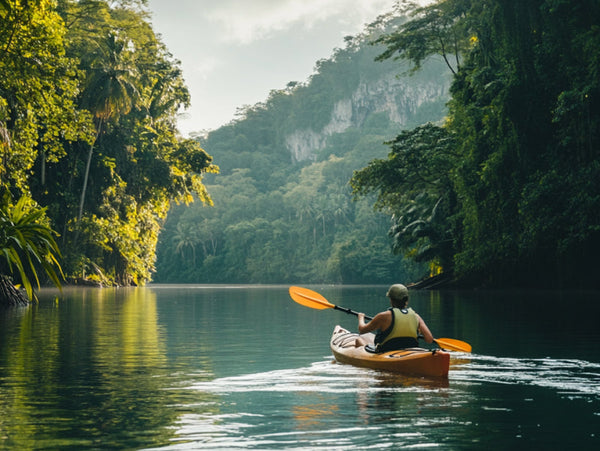What To Do When Your Kayak Capsizes

If there’s one part of kayaking that’s not fun, it’s when your kayak flips over.
There's many ways your kayak can flip, but the most common ones are big waves, strong currents and excessive weight.
Although kayaks are designed for maximum stability, accidents happen and knowing what to do can help you avoid an unpleasant experience.
There are three things to take into consideration in the event your kayak flips:
Remain calm. Kayaks float and with the right technique, it’s possible to right and re-enter your kayak within minutes.
Wear a PFD (personal flotation device). A PFD is an essential piece of gear regardless of your destination or experience level. Your kayak floats but how about you?
Practice beforehand. There’s no reason to wait until an emergency. You should be practicing in calm shallow water and know exactly what you’re doing ahead of time in order to make the process fast and simple.

Here’s the correct way to re-enter the two main types of kayaks:
Sit-on-top kayaks. The advantage of this type of kayak is that it’s easy to enter and exit, making it nearly impossible to get stuck in the event that you capsize.
✔️ Position yourself on the side of your kayak directly in the middle.
✔️ Boost your body over the top of your overturned kayak and grab the opposite side/edge with your hands.
✔️ Slowly pull the kayak towards your body and roll (or flip) the kayak right-side up as you slide back into the water.
✔️ To re-enter, position yourself on the side of your kayak directly in the middle and boost yourself up until you’re your body is lying across the seat.
✔️ Ensure you’re stable and twist your body around until you’re back in the seated position.
✔️ Because there’s no cockpit, you should have very little water inside your kayak.
Sit-inside kayaks. This style of kayak can be a little more challenging, but is still easily doable with practice and the correct accessories.
To achieve a wet exit, start by placing your hands on opposite sides of your cockpit rim and pushing your body out. If you wear a spray skirt, lean forward and pull the grab loop up and back to release it first.
There’s two ways to right your capsized sit-inside kayak.
The first way is to follow the same method as a sit-on-top kayak.
✔️ Position yourself on the side of your kayak directly in the middle.
✔️ Boost your body over the top of your overturned kayak and grab the opposite side/edge with your hands.
✔️ Slowly pull the kayak towards your body and roll (or flip) the kayak right-side up as you slide back into the water.
The other option is to swim underneath your kayak, and quickly push the kayak up and over in one smooth motion. This technique requires more strength and can be a little more challenging for certain people.
✔️ To re-enter, place yourself at the rear of the kayak.
✔️ Use both hands to push/pull your body up on top of the kayak while aggressively kicking your legs.
✔️ Once your body is lying on top of the rear of the kayak, move into a sitting position with your legs spread apart, hanging one leg over each side of the kayak.
✔️ Slowly scoot forward until you position yourself back in the cockpit seat. Balance is key.
With sit-inside kayaks, it’s inevitable that water will get inside. This is where a bilge pump and sponge will come in handy. Simply remove as much water as possible with the pump and then use the sponge to absorb anything the pump cannot remove.

As we mentioned earlier in the article, it’s best to practice these recovery methods, not just read about them. Take lessons, watch videos, and rehearse on calm waters.
Here’s a list of accessories that all kayakers should think about in the event your kayak capsizes.
Paddle Float – A small inflatable tube/ cushion that attaches to the blade of your paddle. It keeps your paddle blade afloat and gives you something to push off of when lifting your body to re-enter your kayak.
Bilge Pump – A small portable hand pump that allows you to remove excess water from your kayak cockpit.
Kayak Sponge – A large sponge used to soak up excess water from inside your cockpit. It’s best to use a bilge pump to remove the majority of water and then use a sponge to remove what the bilge pump couldn’t
PFD (Personal Flotation Device) – Otherwise known as a life jacket, a PFD is recommended for all kayakers. You never know when an emergency can present itself and keeping yourself buoyant and safe is highly recommended.
We hope you found this article helpful.
If there’s anything you’d like to add, please share in the comments below.
Spread The Word & Pin It 😊
Disclosure: BEST Marine and Outdoors is a participant in the Amazon Services LLC Associates Program, an affiliate advertising program designed to provide a means for sites to earn advertising fees by advertising and linking to Amazon.com. This means if you click on the links above and purchase an item, we will receive an affiliate commission at no extra cost to you.
1 Response
Leave a comment
Comments will be approved before showing up.
Also in Blog

How to Choose the Right Kayak Anchor
Choosing the right kayak anchor can make all the difference when it comes to staying steady on the water. This guide walks you through everything you need to know about selecting the perfect folding kayak anchor

12 Tips For Safer Kayaking
Being out on the water for a relaxing paddle in your kayak is certainly a feeling like no other. The calm that comes over us. The feeling of being connected with nature. The escape from the daily grind…. It’s all there!. But like most sports, kayaking does carry some risk. Here's some tips on being a more prepared kayaker.



Glyn
March 28, 2025
I have to tell my experience.I grew up swimming.Life savers Certificate.Grew up sailing.So my family loves the lake and ocean.By sister and I have kayaked for over 20 years.i’m no expert.so one time on a normal lake trip I slipped in knee deep water with my new PDF on that has the automatic inflation cartridge and even though it was not tight.When the explosion happened it almost cut off my air and killed me.Forcing me to my knees in thigh high water using up one of my expensive air cartridges.Awful experience.I didn’t realize that this “practice” would probably save my life.By the way, my sister had to get it off as it kept tightening on me!.A few years later my kayak flipped in the Inner Coastal Waterway in North Carolina.Boats everywhere.Im female and small i didn’t flip my 13 foot kayak back over like you said.I don’t think I could ever flip it again the way I did.Pure adrenaline.As I went under about 15-20 feet straight down.I knew from my “practice “ fall of what to expect with these new automatic personal life jackets.Number one LOOK UP u will be coming up directly underneath your kayak!These new automatic jackets don’t go off at once when you want them to.The day of the “practice” fall.The water was only about 3 feet and it went off like a rocket.It took several feet when I went out of the kayak.Then I flipped it and was close enough to drag it to shore where it was so full of water my niece had to get it out and then come back for me.The shore I was on actually was an island with no where for me to put my foot.So use a waterproof bag for phone and key.Mine was secure and both survived.And my favorite water container also made it through the ordeal.I was so mad I had to go buy another cartridge for my PFD when I fell.But it turned out to have saved my very LIFE! I go all the time in the lake, ocean and the waterways and I always wear a vest!You never know what could happen!So remember don’t panic the automatic vests will explode and look up so you don’t slam into your kayak on the way up.I was directly underneath mine.But because of my “practice” fall I was ready in this disaster.Because my foot hit the rag on the back of the kayak for transportation.And that really could have cost me my life right there.But i didn’t panic and thought “That’s not a sea creature. That’s the car rag.” So please practice fitting each year of your gear. It could mean the difference of a life! And that life is yours. No matter how good of a swimmer you are.